Railway System Engineering Report: Development and Challenges
VerifiedAdded on 2020/04/29
|30
|6477
|53
Report
AI Summary
This research report delves into the multifaceted field of railway system engineering, focusing on the proposed development of the Moorland & City railway company, particularly its plans to connect Leek and Alton Tower stations. The report examines various aspects of railway engineering, including mechanical, electrical, and civil engineering, as well as systems integration. It explores contemporary changes in customer demands, such as convenience, safety, and cost, and assesses the capability of the railway sector in meeting these needs. The report analyzes the demand in interurban connections, considering factors like proximity, scheduling, congestion, reliability, relevance, and efficiency. It also discusses enhancements to the railway system's capability, including terminals, stations, track capacity, and train and junction improvements. Furthermore, the report addresses stakeholder challenges, environmental impacts, and operational efficiency, providing a comprehensive overview of the railway engineering landscape and its future prospects.
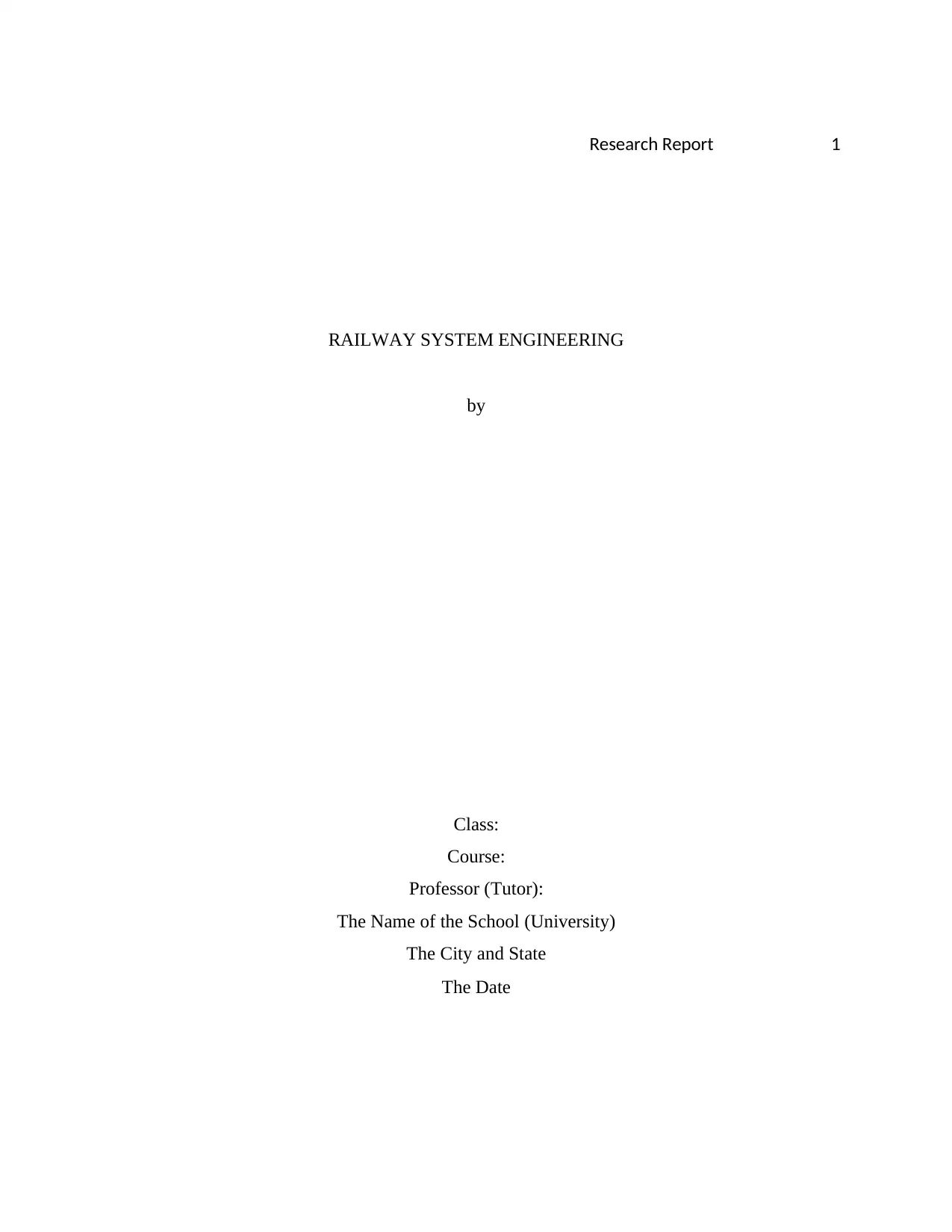
Research Report 1
RAILWAY SYSTEM ENGINEERING
by
Class:
Course:
Professor (Tutor):
The Name of the School (University)
The City and State
The Date
RAILWAY SYSTEM ENGINEERING
by
Class:
Course:
Professor (Tutor):
The Name of the School (University)
The City and State
The Date
Paraphrase This Document
Need a fresh take? Get an instant paraphrase of this document with our AI Paraphraser
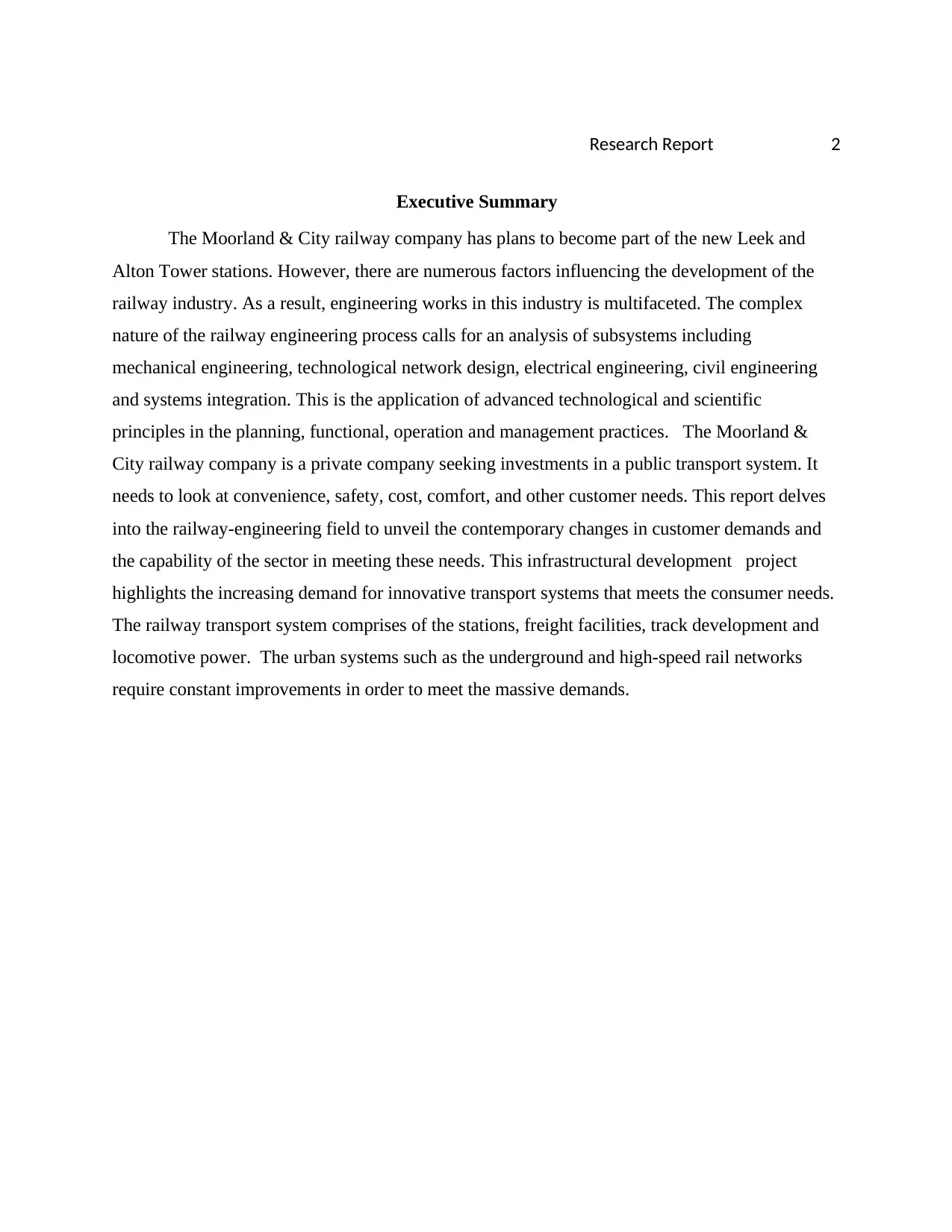
Research Report 2
Executive Summary
The Moorland & City railway company has plans to become part of the new Leek and
Alton Tower stations. However, there are numerous factors influencing the development of the
railway industry. As a result, engineering works in this industry is multifaceted. The complex
nature of the railway engineering process calls for an analysis of subsystems including
mechanical engineering, technological network design, electrical engineering, civil engineering
and systems integration. This is the application of advanced technological and scientific
principles in the planning, functional, operation and management practices. The Moorland &
City railway company is a private company seeking investments in a public transport system. It
needs to look at convenience, safety, cost, comfort, and other customer needs. This report delves
into the railway-engineering field to unveil the contemporary changes in customer demands and
the capability of the sector in meeting these needs. This infrastructural development project
highlights the increasing demand for innovative transport systems that meets the consumer needs.
The railway transport system comprises of the stations, freight facilities, track development and
locomotive power. The urban systems such as the underground and high-speed rail networks
require constant improvements in order to meet the massive demands.
Executive Summary
The Moorland & City railway company has plans to become part of the new Leek and
Alton Tower stations. However, there are numerous factors influencing the development of the
railway industry. As a result, engineering works in this industry is multifaceted. The complex
nature of the railway engineering process calls for an analysis of subsystems including
mechanical engineering, technological network design, electrical engineering, civil engineering
and systems integration. This is the application of advanced technological and scientific
principles in the planning, functional, operation and management practices. The Moorland &
City railway company is a private company seeking investments in a public transport system. It
needs to look at convenience, safety, cost, comfort, and other customer needs. This report delves
into the railway-engineering field to unveil the contemporary changes in customer demands and
the capability of the sector in meeting these needs. This infrastructural development project
highlights the increasing demand for innovative transport systems that meets the consumer needs.
The railway transport system comprises of the stations, freight facilities, track development and
locomotive power. The urban systems such as the underground and high-speed rail networks
require constant improvements in order to meet the massive demands.
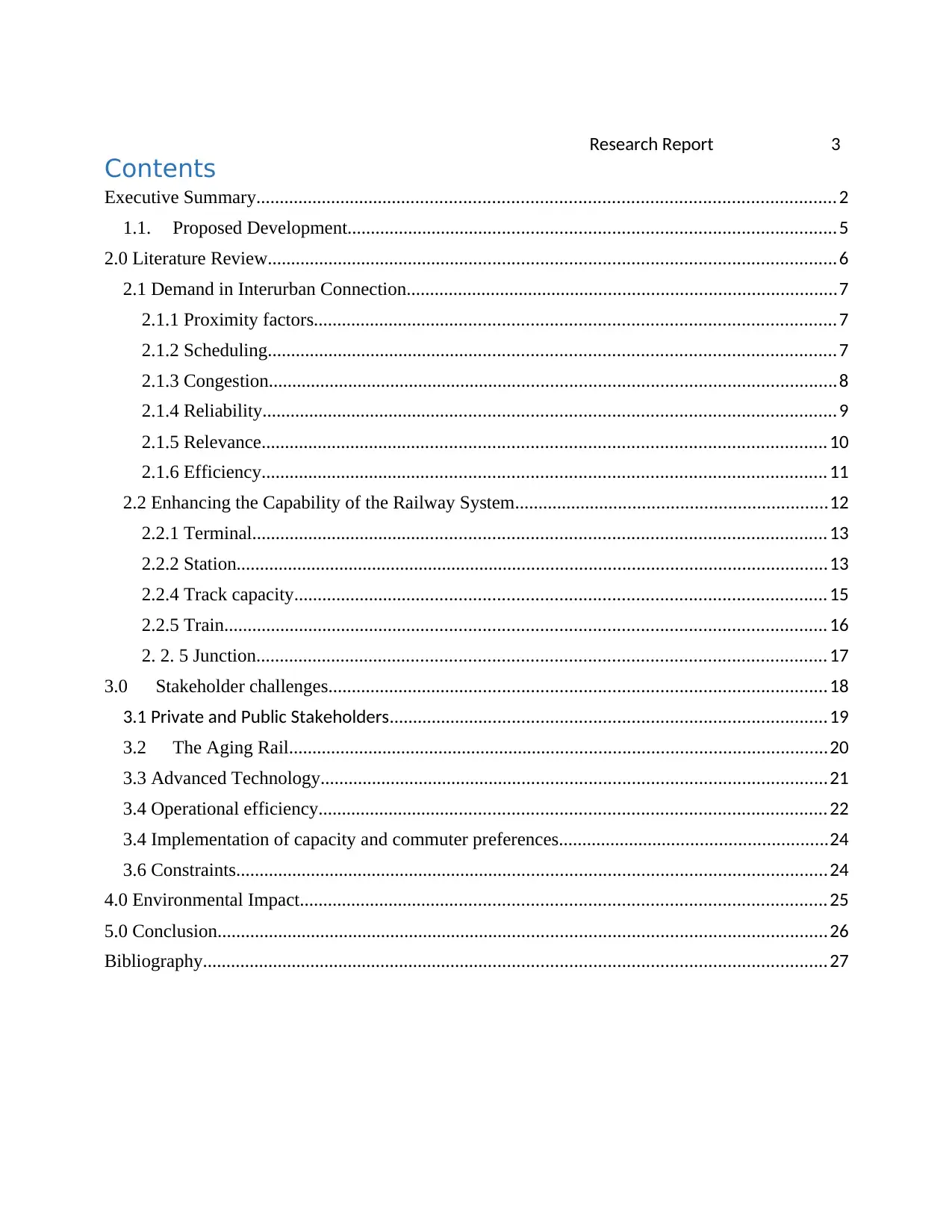
Research Report 3
Contents
Executive Summary.......................................................................................................................... 2
1.1. Proposed Development.......................................................................................................5
2.0 Literature Review........................................................................................................................6
2.1 Demand in Interurban Connection...........................................................................................7
2.1.1 Proximity factors.............................................................................................................. 7
2.1.2 Scheduling........................................................................................................................ 7
2.1.3 Congestion........................................................................................................................8
2.1.4 Reliability......................................................................................................................... 9
2.1.5 Relevance....................................................................................................................... 10
2.1.6 Efficiency....................................................................................................................... 11
2.2 Enhancing the Capability of the Railway System..................................................................12
2.2.1 Terminal......................................................................................................................... 13
2.2.2 Station.............................................................................................................................13
2.2.4 Track capacity................................................................................................................ 15
2.2.5 Train............................................................................................................................... 16
2. 2. 5 Junction........................................................................................................................ 17
3.0 Stakeholder challenges......................................................................................................... 18
3.1 Private and Public Stakeholders............................................................................................19
3.2 The Aging Rail..................................................................................................................20
3.3 Advanced Technology...........................................................................................................21
3.4 Operational efficiency........................................................................................................... 22
3.4 Implementation of capacity and commuter preferences.........................................................24
3.6 Constraints.............................................................................................................................24
4.0 Environmental Impact............................................................................................................... 25
5.0 Conclusion.................................................................................................................................26
Bibliography....................................................................................................................................27
Contents
Executive Summary.......................................................................................................................... 2
1.1. Proposed Development.......................................................................................................5
2.0 Literature Review........................................................................................................................6
2.1 Demand in Interurban Connection...........................................................................................7
2.1.1 Proximity factors.............................................................................................................. 7
2.1.2 Scheduling........................................................................................................................ 7
2.1.3 Congestion........................................................................................................................8
2.1.4 Reliability......................................................................................................................... 9
2.1.5 Relevance....................................................................................................................... 10
2.1.6 Efficiency....................................................................................................................... 11
2.2 Enhancing the Capability of the Railway System..................................................................12
2.2.1 Terminal......................................................................................................................... 13
2.2.2 Station.............................................................................................................................13
2.2.4 Track capacity................................................................................................................ 15
2.2.5 Train............................................................................................................................... 16
2. 2. 5 Junction........................................................................................................................ 17
3.0 Stakeholder challenges......................................................................................................... 18
3.1 Private and Public Stakeholders............................................................................................19
3.2 The Aging Rail..................................................................................................................20
3.3 Advanced Technology...........................................................................................................21
3.4 Operational efficiency........................................................................................................... 22
3.4 Implementation of capacity and commuter preferences.........................................................24
3.6 Constraints.............................................................................................................................24
4.0 Environmental Impact............................................................................................................... 25
5.0 Conclusion.................................................................................................................................26
Bibliography....................................................................................................................................27
⊘ This is a preview!⊘
Do you want full access?
Subscribe today to unlock all pages.

Trusted by 1+ million students worldwide
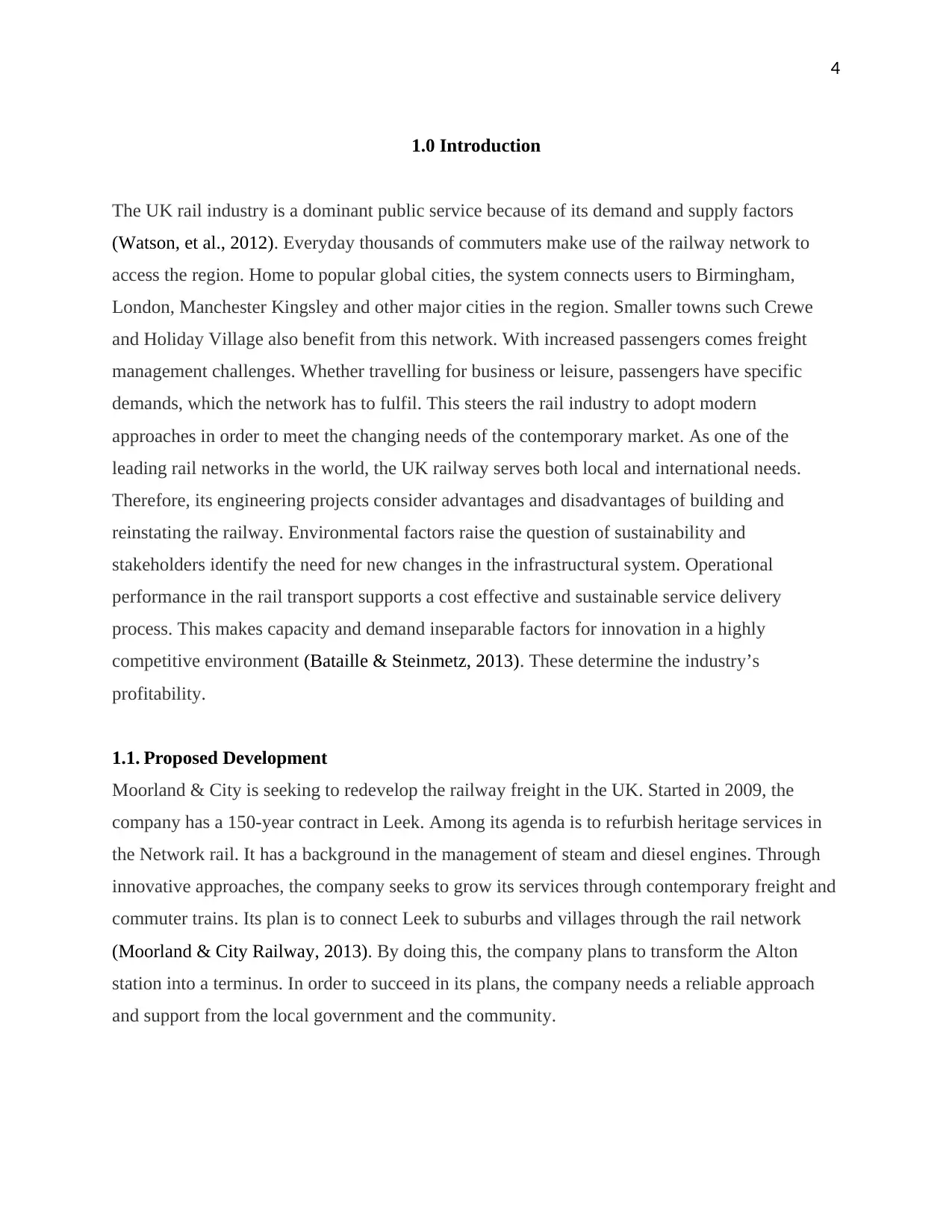
4
1.0 Introduction
The UK rail industry is a dominant public service because of its demand and supply factors
(Watson, et al., 2012). Everyday thousands of commuters make use of the railway network to
access the region. Home to popular global cities, the system connects users to Birmingham,
London, Manchester Kingsley and other major cities in the region. Smaller towns such Crewe
and Holiday Village also benefit from this network. With increased passengers comes freight
management challenges. Whether travelling for business or leisure, passengers have specific
demands, which the network has to fulfil. This steers the rail industry to adopt modern
approaches in order to meet the changing needs of the contemporary market. As one of the
leading rail networks in the world, the UK railway serves both local and international needs.
Therefore, its engineering projects consider advantages and disadvantages of building and
reinstating the railway. Environmental factors raise the question of sustainability and
stakeholders identify the need for new changes in the infrastructural system. Operational
performance in the rail transport supports a cost effective and sustainable service delivery
process. This makes capacity and demand inseparable factors for innovation in a highly
competitive environment (Bataille & Steinmetz, 2013). These determine the industry’s
profitability.
1.1. Proposed Development
Moorland & City is seeking to redevelop the railway freight in the UK. Started in 2009, the
company has a 150-year contract in Leek. Among its agenda is to refurbish heritage services in
the Network rail. It has a background in the management of steam and diesel engines. Through
innovative approaches, the company seeks to grow its services through contemporary freight and
commuter trains. Its plan is to connect Leek to suburbs and villages through the rail network
(Moorland & City Railway, 2013). By doing this, the company plans to transform the Alton
station into a terminus. In order to succeed in its plans, the company needs a reliable approach
and support from the local government and the community.
1.0 Introduction
The UK rail industry is a dominant public service because of its demand and supply factors
(Watson, et al., 2012). Everyday thousands of commuters make use of the railway network to
access the region. Home to popular global cities, the system connects users to Birmingham,
London, Manchester Kingsley and other major cities in the region. Smaller towns such Crewe
and Holiday Village also benefit from this network. With increased passengers comes freight
management challenges. Whether travelling for business or leisure, passengers have specific
demands, which the network has to fulfil. This steers the rail industry to adopt modern
approaches in order to meet the changing needs of the contemporary market. As one of the
leading rail networks in the world, the UK railway serves both local and international needs.
Therefore, its engineering projects consider advantages and disadvantages of building and
reinstating the railway. Environmental factors raise the question of sustainability and
stakeholders identify the need for new changes in the infrastructural system. Operational
performance in the rail transport supports a cost effective and sustainable service delivery
process. This makes capacity and demand inseparable factors for innovation in a highly
competitive environment (Bataille & Steinmetz, 2013). These determine the industry’s
profitability.
1.1. Proposed Development
Moorland & City is seeking to redevelop the railway freight in the UK. Started in 2009, the
company has a 150-year contract in Leek. Among its agenda is to refurbish heritage services in
the Network rail. It has a background in the management of steam and diesel engines. Through
innovative approaches, the company seeks to grow its services through contemporary freight and
commuter trains. Its plan is to connect Leek to suburbs and villages through the rail network
(Moorland & City Railway, 2013). By doing this, the company plans to transform the Alton
station into a terminus. In order to succeed in its plans, the company needs a reliable approach
and support from the local government and the community.
Paraphrase This Document
Need a fresh take? Get an instant paraphrase of this document with our AI Paraphraser
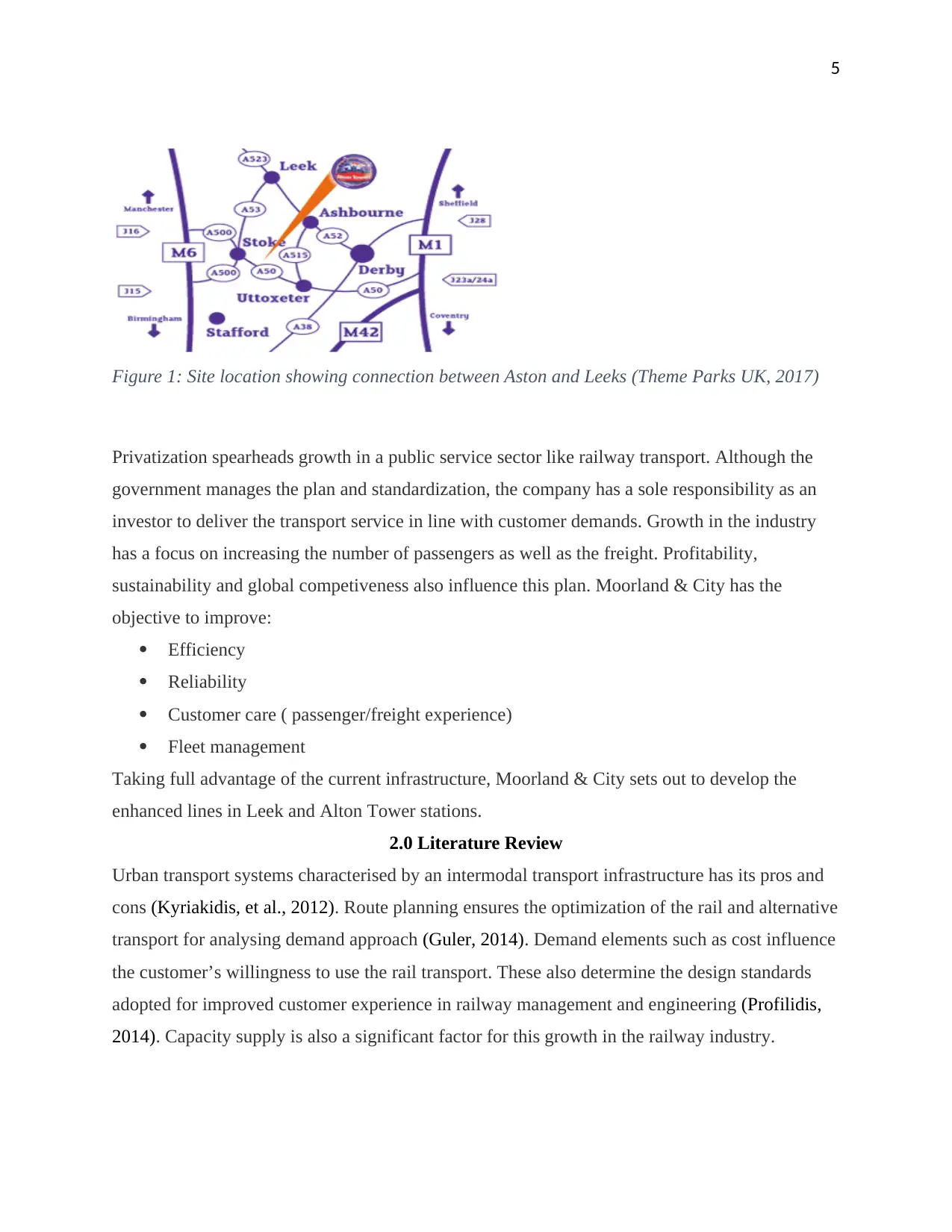
5
Figure 1: Site location showing connection between Aston and Leeks (Theme Parks UK, 2017)
Privatization spearheads growth in a public service sector like railway transport. Although the
government manages the plan and standardization, the company has a sole responsibility as an
investor to deliver the transport service in line with customer demands. Growth in the industry
has a focus on increasing the number of passengers as well as the freight. Profitability,
sustainability and global competiveness also influence this plan. Moorland & City has the
objective to improve:
Efficiency
Reliability
Customer care ( passenger/freight experience)
Fleet management
Taking full advantage of the current infrastructure, Moorland & City sets out to develop the
enhanced lines in Leek and Alton Tower stations.
2.0 Literature Review
Urban transport systems characterised by an intermodal transport infrastructure has its pros and
cons (Kyriakidis, et al., 2012). Route planning ensures the optimization of the rail and alternative
transport for analysing demand approach (Guler, 2014). Demand elements such as cost influence
the customer’s willingness to use the rail transport. These also determine the design standards
adopted for improved customer experience in railway management and engineering (Profilidis,
2014). Capacity supply is also a significant factor for this growth in the railway industry.
Figure 1: Site location showing connection between Aston and Leeks (Theme Parks UK, 2017)
Privatization spearheads growth in a public service sector like railway transport. Although the
government manages the plan and standardization, the company has a sole responsibility as an
investor to deliver the transport service in line with customer demands. Growth in the industry
has a focus on increasing the number of passengers as well as the freight. Profitability,
sustainability and global competiveness also influence this plan. Moorland & City has the
objective to improve:
Efficiency
Reliability
Customer care ( passenger/freight experience)
Fleet management
Taking full advantage of the current infrastructure, Moorland & City sets out to develop the
enhanced lines in Leek and Alton Tower stations.
2.0 Literature Review
Urban transport systems characterised by an intermodal transport infrastructure has its pros and
cons (Kyriakidis, et al., 2012). Route planning ensures the optimization of the rail and alternative
transport for analysing demand approach (Guler, 2014). Demand elements such as cost influence
the customer’s willingness to use the rail transport. These also determine the design standards
adopted for improved customer experience in railway management and engineering (Profilidis,
2014). Capacity supply is also a significant factor for this growth in the railway industry.
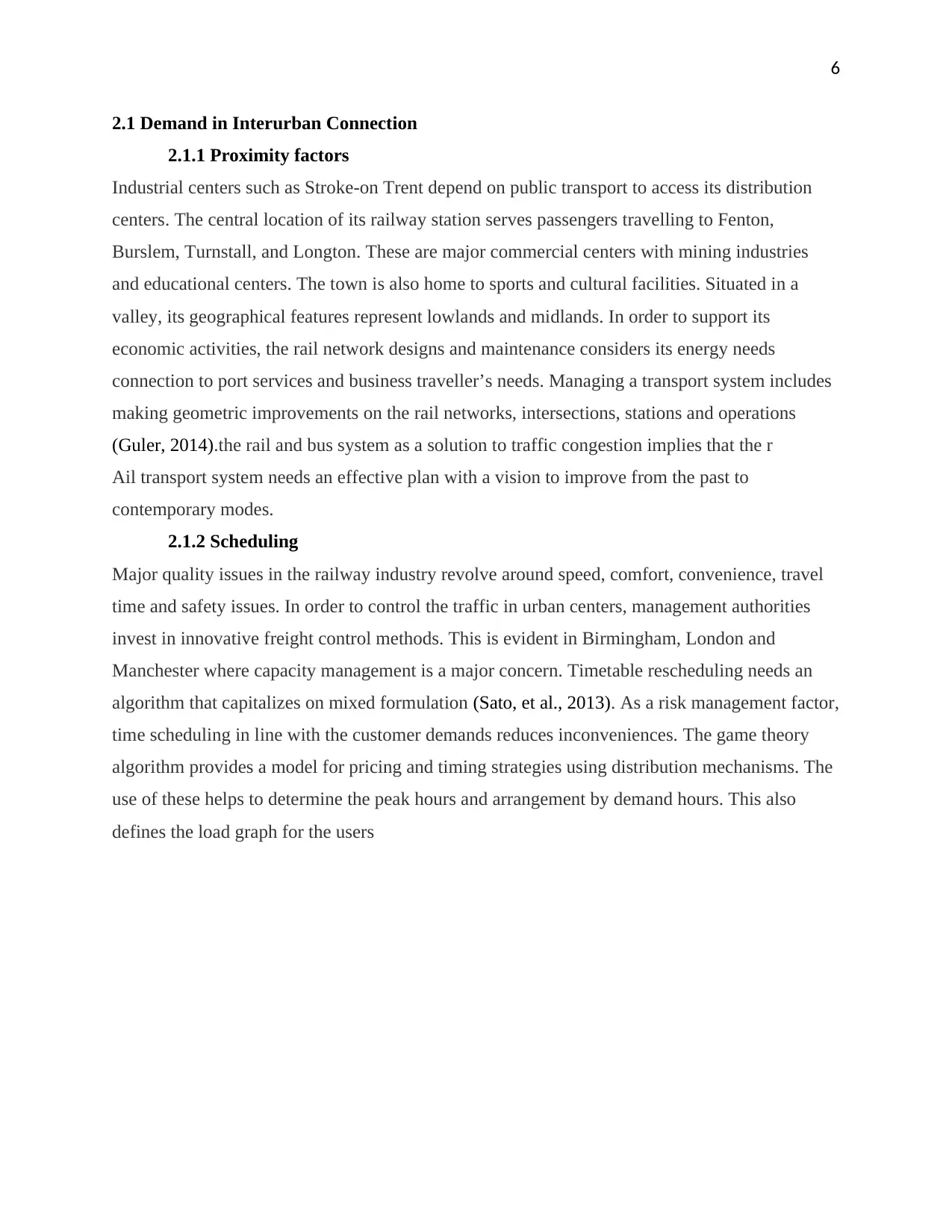
6
2.1 Demand in Interurban Connection
2.1.1 Proximity factors
Industrial centers such as Stroke-on Trent depend on public transport to access its distribution
centers. The central location of its railway station serves passengers travelling to Fenton,
Burslem, Turnstall, and Longton. These are major commercial centers with mining industries
and educational centers. The town is also home to sports and cultural facilities. Situated in a
valley, its geographical features represent lowlands and midlands. In order to support its
economic activities, the rail network designs and maintenance considers its energy needs
connection to port services and business traveller’s needs. Managing a transport system includes
making geometric improvements on the rail networks, intersections, stations and operations
(Guler, 2014).the rail and bus system as a solution to traffic congestion implies that the r
Ail transport system needs an effective plan with a vision to improve from the past to
contemporary modes.
2.1.2 Scheduling
Major quality issues in the railway industry revolve around speed, comfort, convenience, travel
time and safety issues. In order to control the traffic in urban centers, management authorities
invest in innovative freight control methods. This is evident in Birmingham, London and
Manchester where capacity management is a major concern. Timetable rescheduling needs an
algorithm that capitalizes on mixed formulation (Sato, et al., 2013). As a risk management factor,
time scheduling in line with the customer demands reduces inconveniences. The game theory
algorithm provides a model for pricing and timing strategies using distribution mechanisms. The
use of these helps to determine the peak hours and arrangement by demand hours. This also
defines the load graph for the users
2.1 Demand in Interurban Connection
2.1.1 Proximity factors
Industrial centers such as Stroke-on Trent depend on public transport to access its distribution
centers. The central location of its railway station serves passengers travelling to Fenton,
Burslem, Turnstall, and Longton. These are major commercial centers with mining industries
and educational centers. The town is also home to sports and cultural facilities. Situated in a
valley, its geographical features represent lowlands and midlands. In order to support its
economic activities, the rail network designs and maintenance considers its energy needs
connection to port services and business traveller’s needs. Managing a transport system includes
making geometric improvements on the rail networks, intersections, stations and operations
(Guler, 2014).the rail and bus system as a solution to traffic congestion implies that the r
Ail transport system needs an effective plan with a vision to improve from the past to
contemporary modes.
2.1.2 Scheduling
Major quality issues in the railway industry revolve around speed, comfort, convenience, travel
time and safety issues. In order to control the traffic in urban centers, management authorities
invest in innovative freight control methods. This is evident in Birmingham, London and
Manchester where capacity management is a major concern. Timetable rescheduling needs an
algorithm that capitalizes on mixed formulation (Sato, et al., 2013). As a risk management factor,
time scheduling in line with the customer demands reduces inconveniences. The game theory
algorithm provides a model for pricing and timing strategies using distribution mechanisms. The
use of these helps to determine the peak hours and arrangement by demand hours. This also
defines the load graph for the users
⊘ This is a preview!⊘
Do you want full access?
Subscribe today to unlock all pages.

Trusted by 1+ million students worldwide
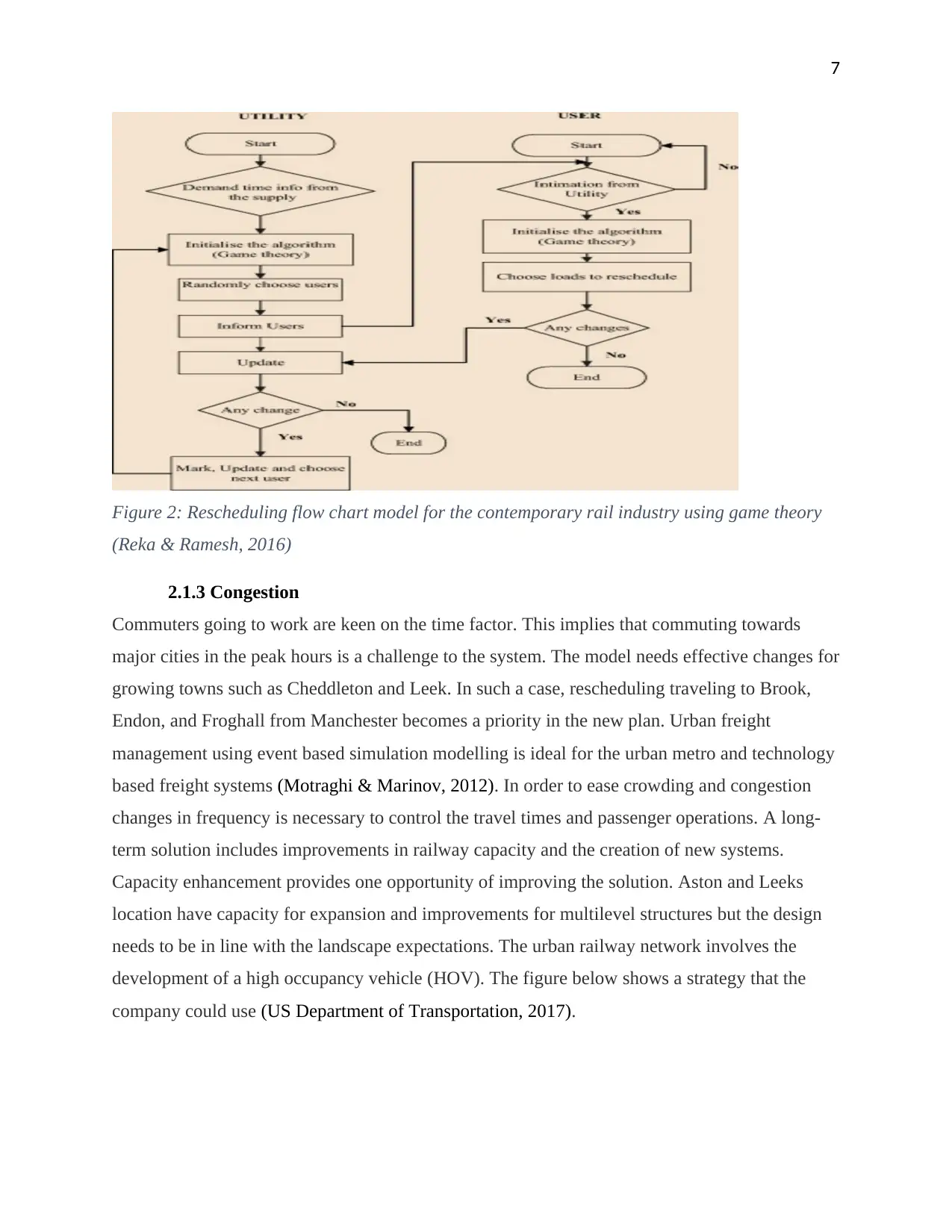
7
Figure 2: Rescheduling flow chart model for the contemporary rail industry using game theory
(Reka & Ramesh, 2016)
2.1.3 Congestion
Commuters going to work are keen on the time factor. This implies that commuting towards
major cities in the peak hours is a challenge to the system. The model needs effective changes for
growing towns such as Cheddleton and Leek. In such a case, rescheduling traveling to Brook,
Endon, and Froghall from Manchester becomes a priority in the new plan. Urban freight
management using event based simulation modelling is ideal for the urban metro and technology
based freight systems (Motraghi & Marinov, 2012). In order to ease crowding and congestion
changes in frequency is necessary to control the travel times and passenger operations. A long-
term solution includes improvements in railway capacity and the creation of new systems.
Capacity enhancement provides one opportunity of improving the solution. Aston and Leeks
location have capacity for expansion and improvements for multilevel structures but the design
needs to be in line with the landscape expectations. The urban railway network involves the
development of a high occupancy vehicle (HOV). The figure below shows a strategy that the
company could use (US Department of Transportation, 2017).
Figure 2: Rescheduling flow chart model for the contemporary rail industry using game theory
(Reka & Ramesh, 2016)
2.1.3 Congestion
Commuters going to work are keen on the time factor. This implies that commuting towards
major cities in the peak hours is a challenge to the system. The model needs effective changes for
growing towns such as Cheddleton and Leek. In such a case, rescheduling traveling to Brook,
Endon, and Froghall from Manchester becomes a priority in the new plan. Urban freight
management using event based simulation modelling is ideal for the urban metro and technology
based freight systems (Motraghi & Marinov, 2012). In order to ease crowding and congestion
changes in frequency is necessary to control the travel times and passenger operations. A long-
term solution includes improvements in railway capacity and the creation of new systems.
Capacity enhancement provides one opportunity of improving the solution. Aston and Leeks
location have capacity for expansion and improvements for multilevel structures but the design
needs to be in line with the landscape expectations. The urban railway network involves the
development of a high occupancy vehicle (HOV). The figure below shows a strategy that the
company could use (US Department of Transportation, 2017).
Paraphrase This Document
Need a fresh take? Get an instant paraphrase of this document with our AI Paraphraser
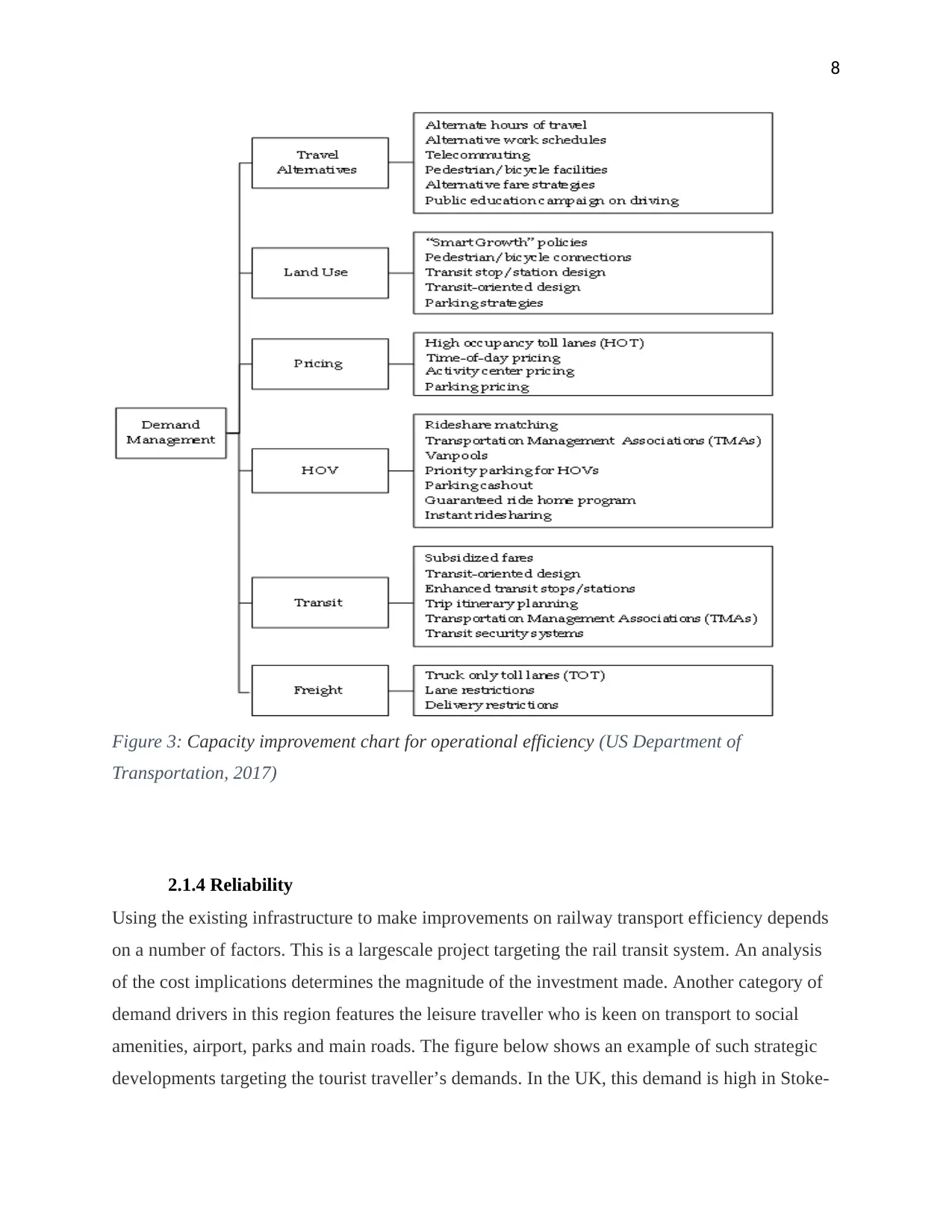
8
Figure 3: Capacity improvement chart for operational efficiency (US Department of
Transportation, 2017)
2.1.4 Reliability
Using the existing infrastructure to make improvements on railway transport efficiency depends
on a number of factors. This is a largescale project targeting the rail transit system. An analysis
of the cost implications determines the magnitude of the investment made. Another category of
demand drivers in this region features the leisure traveller who is keen on transport to social
amenities, airport, parks and main roads. The figure below shows an example of such strategic
developments targeting the tourist traveller’s demands. In the UK, this demand is high in Stoke-
Figure 3: Capacity improvement chart for operational efficiency (US Department of
Transportation, 2017)
2.1.4 Reliability
Using the existing infrastructure to make improvements on railway transport efficiency depends
on a number of factors. This is a largescale project targeting the rail transit system. An analysis
of the cost implications determines the magnitude of the investment made. Another category of
demand drivers in this region features the leisure traveller who is keen on transport to social
amenities, airport, parks and main roads. The figure below shows an example of such strategic
developments targeting the tourist traveller’s demands. In the UK, this demand is high in Stoke-
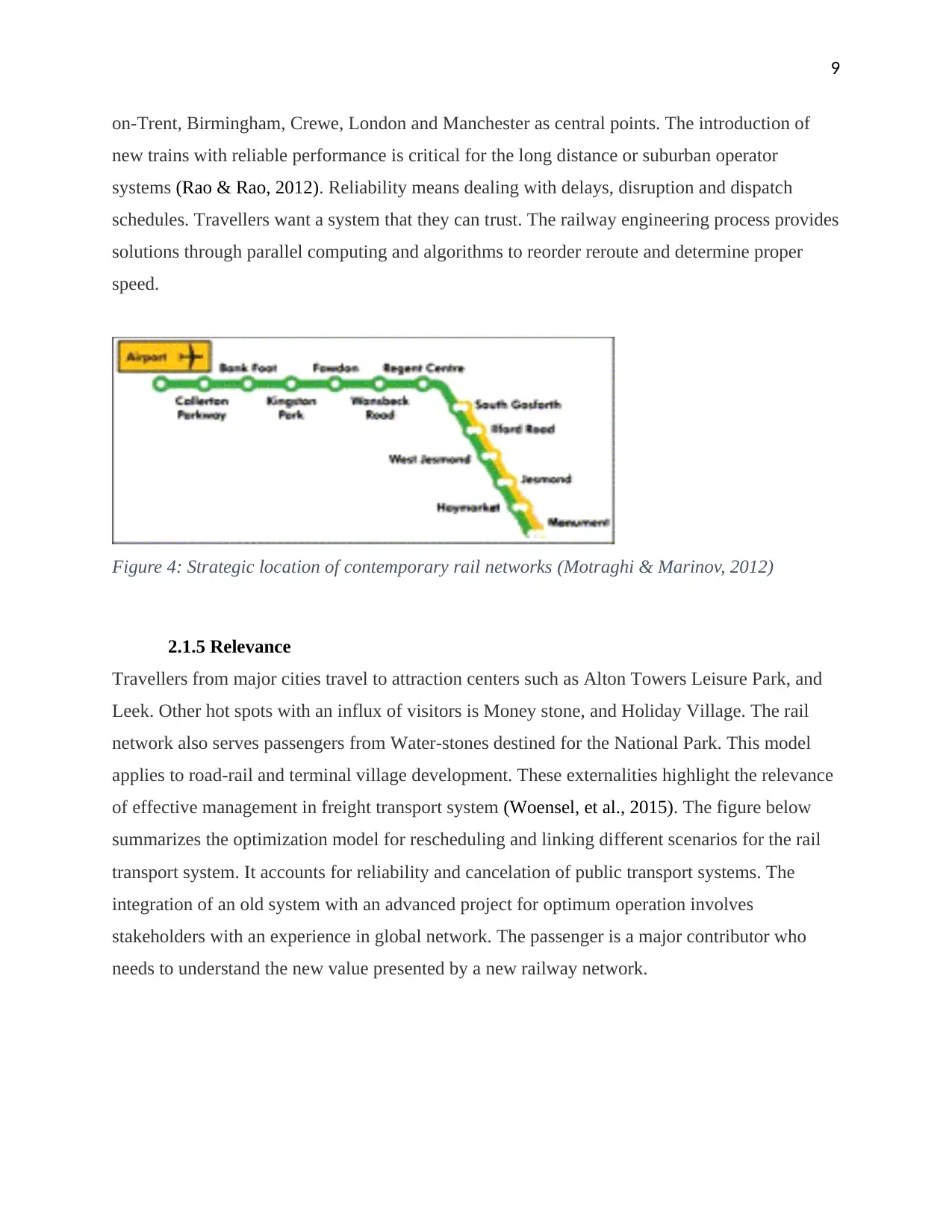
9
on-Trent, Birmingham, Crewe, London and Manchester as central points. The introduction of
new trains with reliable performance is critical for the long distance or suburban operator
systems (Rao & Rao, 2012). Reliability means dealing with delays, disruption and dispatch
schedules. Travellers want a system that they can trust. The railway engineering process provides
solutions through parallel computing and algorithms to reorder reroute and determine proper
speed.
Figure 4: Strategic location of contemporary rail networks (Motraghi & Marinov, 2012)
2.1.5 Relevance
Travellers from major cities travel to attraction centers such as Alton Towers Leisure Park, and
Leek. Other hot spots with an influx of visitors is Money stone, and Holiday Village. The rail
network also serves passengers from Water-stones destined for the National Park. This model
applies to road-rail and terminal village development. These externalities highlight the relevance
of effective management in freight transport system (Woensel, et al., 2015). The figure below
summarizes the optimization model for rescheduling and linking different scenarios for the rail
transport system. It accounts for reliability and cancelation of public transport systems. The
integration of an old system with an advanced project for optimum operation involves
stakeholders with an experience in global network. The passenger is a major contributor who
needs to understand the new value presented by a new railway network.
on-Trent, Birmingham, Crewe, London and Manchester as central points. The introduction of
new trains with reliable performance is critical for the long distance or suburban operator
systems (Rao & Rao, 2012). Reliability means dealing with delays, disruption and dispatch
schedules. Travellers want a system that they can trust. The railway engineering process provides
solutions through parallel computing and algorithms to reorder reroute and determine proper
speed.
Figure 4: Strategic location of contemporary rail networks (Motraghi & Marinov, 2012)
2.1.5 Relevance
Travellers from major cities travel to attraction centers such as Alton Towers Leisure Park, and
Leek. Other hot spots with an influx of visitors is Money stone, and Holiday Village. The rail
network also serves passengers from Water-stones destined for the National Park. This model
applies to road-rail and terminal village development. These externalities highlight the relevance
of effective management in freight transport system (Woensel, et al., 2015). The figure below
summarizes the optimization model for rescheduling and linking different scenarios for the rail
transport system. It accounts for reliability and cancelation of public transport systems. The
integration of an old system with an advanced project for optimum operation involves
stakeholders with an experience in global network. The passenger is a major contributor who
needs to understand the new value presented by a new railway network.
⊘ This is a preview!⊘
Do you want full access?
Subscribe today to unlock all pages.

Trusted by 1+ million students worldwide
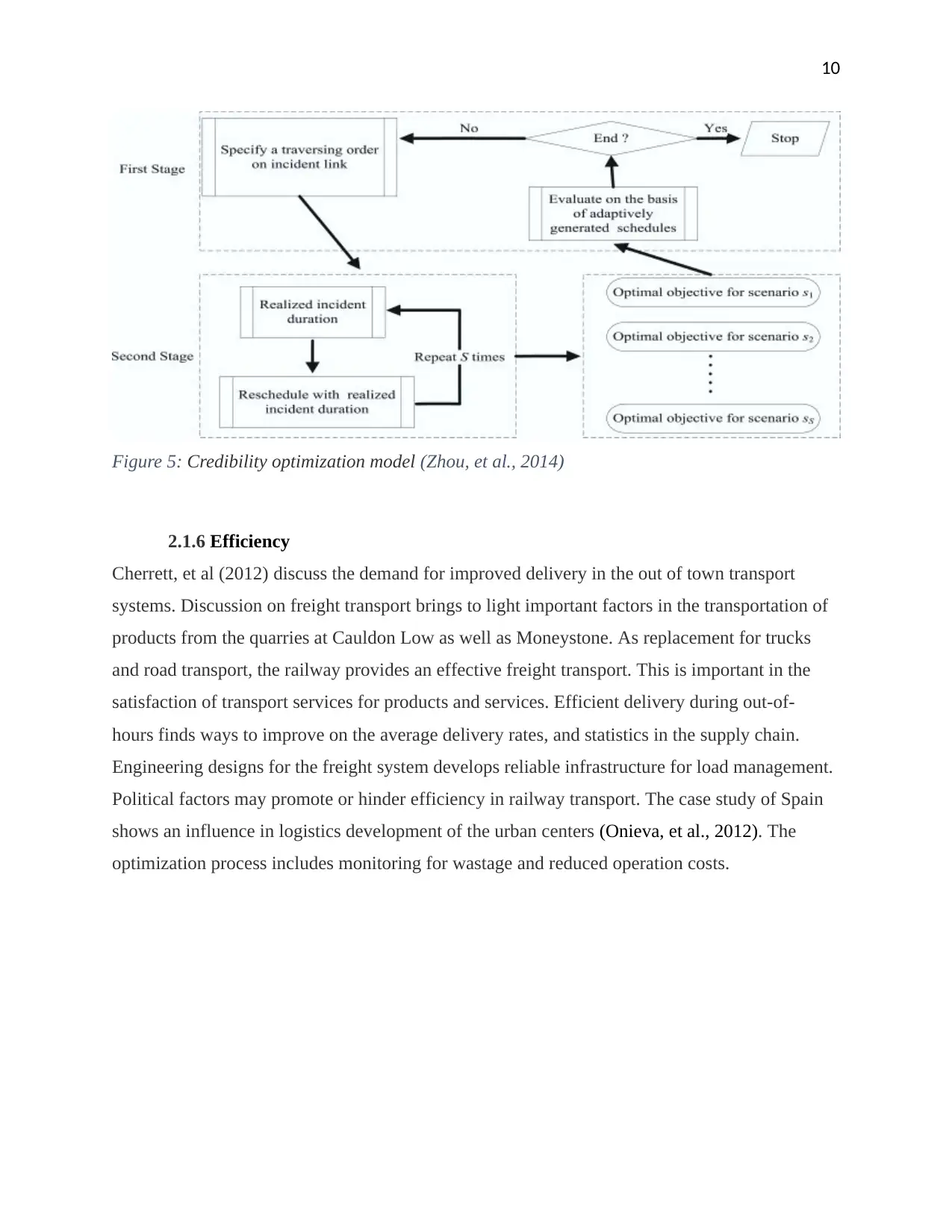
10
Figure 5: Credibility optimization model (Zhou, et al., 2014)
2.1.6 Efficiency
Cherrett, et al (2012) discuss the demand for improved delivery in the out of town transport
systems. Discussion on freight transport brings to light important factors in the transportation of
products from the quarries at Cauldon Low as well as Moneystone. As replacement for trucks
and road transport, the railway provides an effective freight transport. This is important in the
satisfaction of transport services for products and services. Efficient delivery during out-of-
hours finds ways to improve on the average delivery rates, and statistics in the supply chain.
Engineering designs for the freight system develops reliable infrastructure for load management.
Political factors may promote or hinder efficiency in railway transport. The case study of Spain
shows an influence in logistics development of the urban centers (Onieva, et al., 2012). The
optimization process includes monitoring for wastage and reduced operation costs.
Figure 5: Credibility optimization model (Zhou, et al., 2014)
2.1.6 Efficiency
Cherrett, et al (2012) discuss the demand for improved delivery in the out of town transport
systems. Discussion on freight transport brings to light important factors in the transportation of
products from the quarries at Cauldon Low as well as Moneystone. As replacement for trucks
and road transport, the railway provides an effective freight transport. This is important in the
satisfaction of transport services for products and services. Efficient delivery during out-of-
hours finds ways to improve on the average delivery rates, and statistics in the supply chain.
Engineering designs for the freight system develops reliable infrastructure for load management.
Political factors may promote or hinder efficiency in railway transport. The case study of Spain
shows an influence in logistics development of the urban centers (Onieva, et al., 2012). The
optimization process includes monitoring for wastage and reduced operation costs.
Paraphrase This Document
Need a fresh take? Get an instant paraphrase of this document with our AI Paraphraser
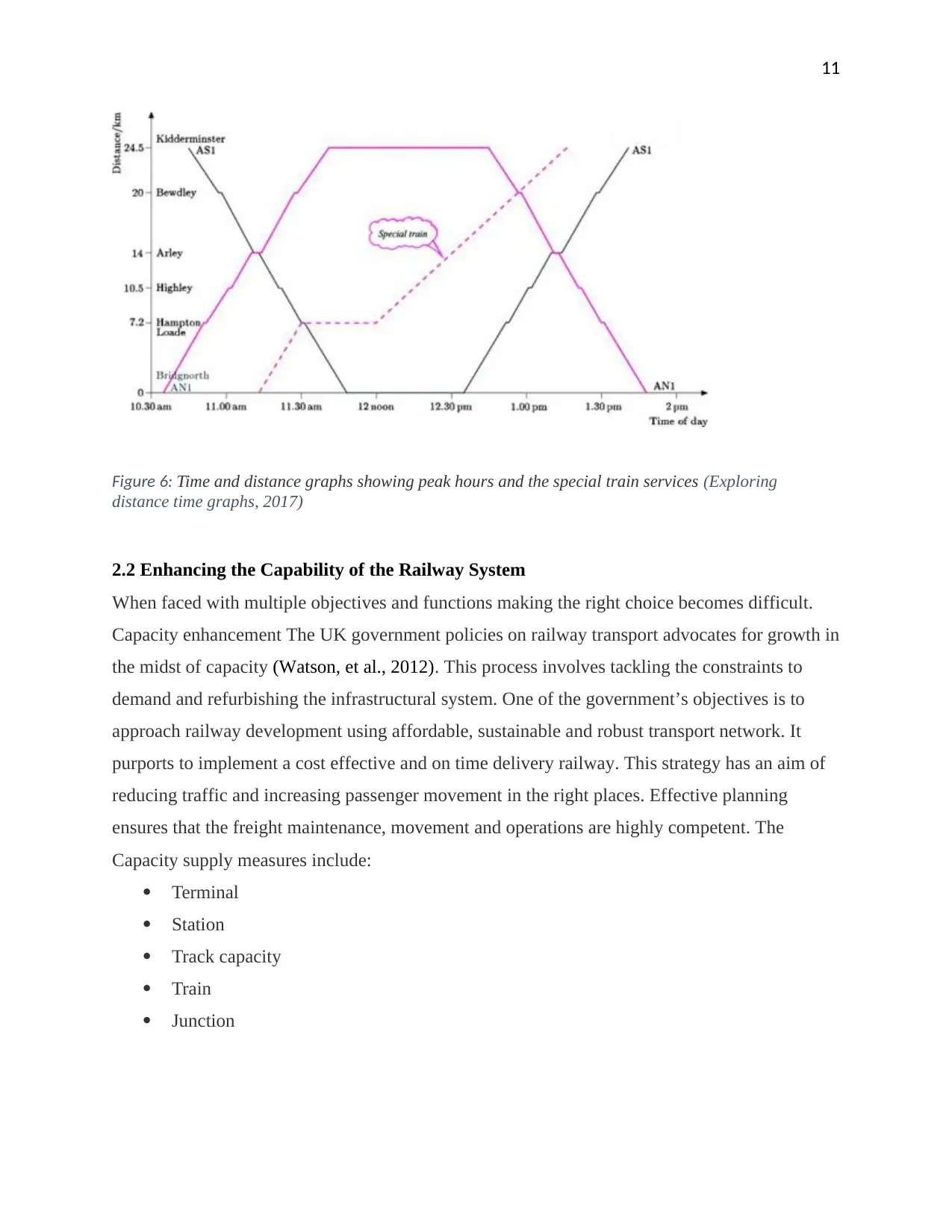
11
Figure 6: Time and distance graphs showing peak hours and the special train services (Exploring
distance time graphs, 2017)
2.2 Enhancing the Capability of the Railway System
When faced with multiple objectives and functions making the right choice becomes difficult.
Capacity enhancement The UK government policies on railway transport advocates for growth in
the midst of capacity (Watson, et al., 2012). This process involves tackling the constraints to
demand and refurbishing the infrastructural system. One of the government’s objectives is to
approach railway development using affordable, sustainable and robust transport network. It
purports to implement a cost effective and on time delivery railway. This strategy has an aim of
reducing traffic and increasing passenger movement in the right places. Effective planning
ensures that the freight maintenance, movement and operations are highly competent. The
Capacity supply measures include:
Terminal
Station
Track capacity
Train
Junction
Figure 6: Time and distance graphs showing peak hours and the special train services (Exploring
distance time graphs, 2017)
2.2 Enhancing the Capability of the Railway System
When faced with multiple objectives and functions making the right choice becomes difficult.
Capacity enhancement The UK government policies on railway transport advocates for growth in
the midst of capacity (Watson, et al., 2012). This process involves tackling the constraints to
demand and refurbishing the infrastructural system. One of the government’s objectives is to
approach railway development using affordable, sustainable and robust transport network. It
purports to implement a cost effective and on time delivery railway. This strategy has an aim of
reducing traffic and increasing passenger movement in the right places. Effective planning
ensures that the freight maintenance, movement and operations are highly competent. The
Capacity supply measures include:
Terminal
Station
Track capacity
Train
Junction
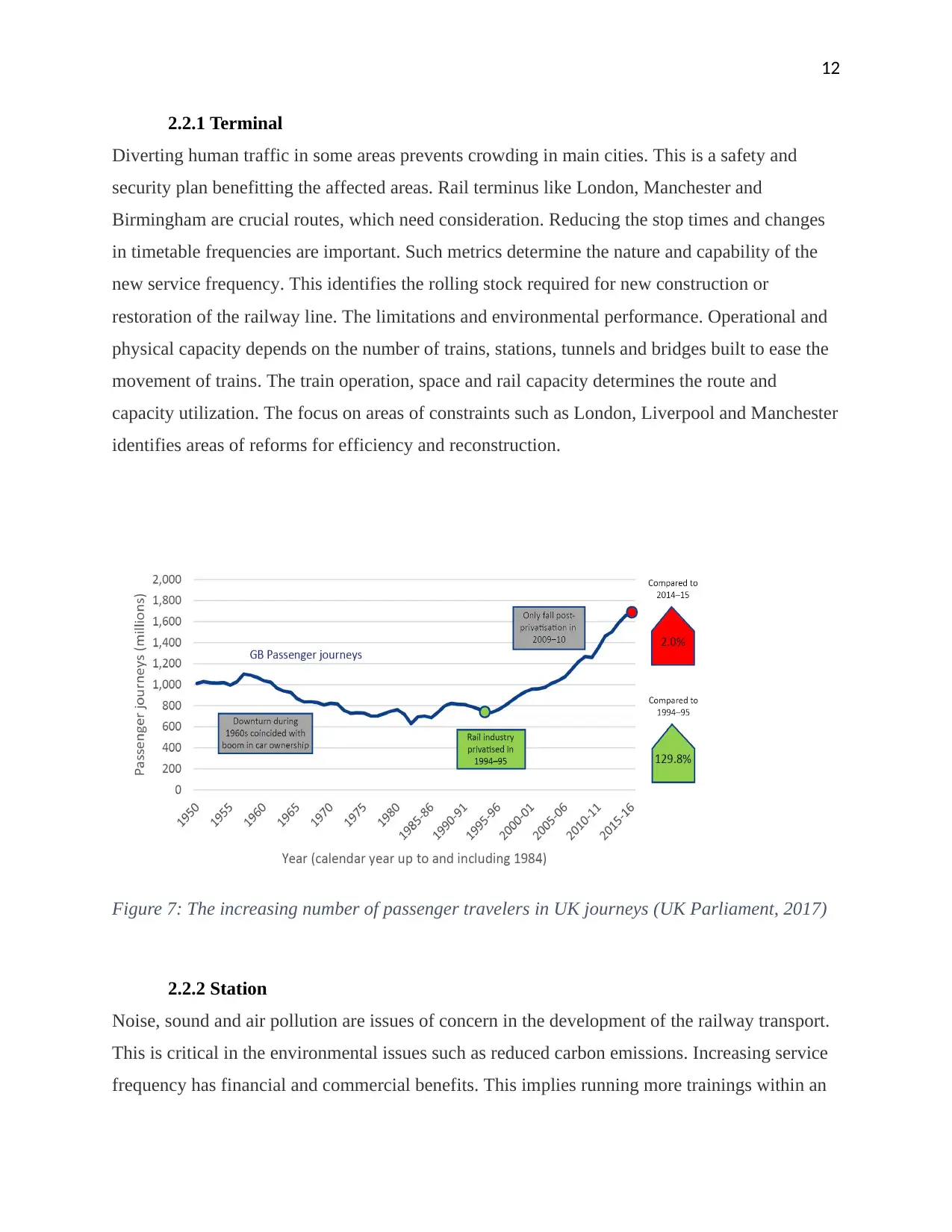
12
2.2.1 Terminal
Diverting human traffic in some areas prevents crowding in main cities. This is a safety and
security plan benefitting the affected areas. Rail terminus like London, Manchester and
Birmingham are crucial routes, which need consideration. Reducing the stop times and changes
in timetable frequencies are important. Such metrics determine the nature and capability of the
new service frequency. This identifies the rolling stock required for new construction or
restoration of the railway line. The limitations and environmental performance. Operational and
physical capacity depends on the number of trains, stations, tunnels and bridges built to ease the
movement of trains. The train operation, space and rail capacity determines the route and
capacity utilization. The focus on areas of constraints such as London, Liverpool and Manchester
identifies areas of reforms for efficiency and reconstruction.
Figure 7: The increasing number of passenger travelers in UK journeys (UK Parliament, 2017)
2.2.2 Station
Noise, sound and air pollution are issues of concern in the development of the railway transport.
This is critical in the environmental issues such as reduced carbon emissions. Increasing service
frequency has financial and commercial benefits. This implies running more trainings within an
2.2.1 Terminal
Diverting human traffic in some areas prevents crowding in main cities. This is a safety and
security plan benefitting the affected areas. Rail terminus like London, Manchester and
Birmingham are crucial routes, which need consideration. Reducing the stop times and changes
in timetable frequencies are important. Such metrics determine the nature and capability of the
new service frequency. This identifies the rolling stock required for new construction or
restoration of the railway line. The limitations and environmental performance. Operational and
physical capacity depends on the number of trains, stations, tunnels and bridges built to ease the
movement of trains. The train operation, space and rail capacity determines the route and
capacity utilization. The focus on areas of constraints such as London, Liverpool and Manchester
identifies areas of reforms for efficiency and reconstruction.
Figure 7: The increasing number of passenger travelers in UK journeys (UK Parliament, 2017)
2.2.2 Station
Noise, sound and air pollution are issues of concern in the development of the railway transport.
This is critical in the environmental issues such as reduced carbon emissions. Increasing service
frequency has financial and commercial benefits. This implies running more trainings within an
⊘ This is a preview!⊘
Do you want full access?
Subscribe today to unlock all pages.

Trusted by 1+ million students worldwide
1 out of 30
Related Documents
Your All-in-One AI-Powered Toolkit for Academic Success.
+13062052269
info@desklib.com
Available 24*7 on WhatsApp / Email
![[object Object]](/_next/static/media/star-bottom.7253800d.svg)
Unlock your academic potential
Copyright © 2020–2025 A2Z Services. All Rights Reserved. Developed and managed by ZUCOL.





